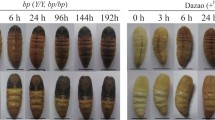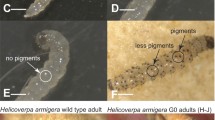Abstract
3-Hydroxykynurenine is virtually absent from st larvae but accumulates during adult development in the puparium. Over the period of adult emergence, the accumulated 3-hydroxykynurenine is excreted so that st adults contain none. Larvae of st fed on tryptophan-C14 medium produce labeled 3-hydroxykynurenine, at a reduced rate, perhaps, compared to wild type. Xanthurenic acid levels in st pupae are similar to those in wild type. Thus the failure of st larvae to accumulate 3-hydroxykynurenine does not seem to be due either to an inability to synthesize this compound or to an excessive rate of its conversion to xanthurenic acid. Rather, it appears that the mechanism of 3-hydroxykynurenine storage during larval life is defective, so that this compound is excreted at an abnormally high rate. The inability of the pigment cells of the eyes of st to synthesize xanthommatin may result from a similar defect in their ability to take up or store 3-hydroxykynurenine.
Similar content being viewed by others
References
Beadle, G. W. (1937a). Development of eye colors in Drosophila: Fat bodies and malpighian tubes as sources of diffusible substances. Proc. Natl. Acad. Sci. 23145.
Beadle, G. W. (1937b). Development of eye colors in Drosophila: Fat bodies and malpighian tubes in relation to diffusible substances. Genetics 22587.
Beadle, G. W., and Ephrussi, B. (1936). The differentiation of eye pigments in Drosophila as studied by transplantation. Genetics 21225.
Bonse, A. (1969). Ueber das Auftreten von Pteridinen, Tryptophan und dessen Derivate in verscheidener Organen der Mutante white von Drosophila melanogaster. Z. Naturforsch. 24b128.
Church, R. B., and Robertson, F. W. (1966). A biochemical study of the growth of Drosophila melanogaster. J. Exp. Zool. 162337.
Green, M. M. (1949). A study of tryptophane in eye color mutants of Drosophila. Genetics 34564.
Grigolo, A., and Laudini, U. (1970). Determinazioni quantitava di alcuni metaboliti del triptofano in ceppi normali e mutanti per il colore degli occhi di Musca domestica L. Biol. Zool. Agr. Bachicolt. (1968/1969, publ. 1970) 911.
Liebenguth, F. (1970). Concerning non-darkening of mutant Habrobracon (Bracon hebetor) eyes as a consequence of a new chromagen-reducing mechanism in insect larvae. Experientia 26659.
Mead, C. G. (1964). A deoxyribonucleic acid-associated ribonucleic acid from Drosophila melanogaster. J. Biol. Chem. 239550.
Nolte, D. J. (1954). The eye pigmentary systems of Drosophila. IV. The pigments of the vermilion group of mutants. J. Genet. 52111.
Phillips, J. P., Simmons, J. R., and Bowman, J. T. (1970). Terminal synthesis of xanthommatin in Drosophila melanogaster I. Roles of phenol oxidase and substrate availability. Biochem. Genet. 4481.
Ryall, R. L., and Howells, A. J. (1974). Ommochrome biosynthetic pathway of Drosophila melanogaster: Variations in levels of enzyme activities and intermediates during adult development. Insect Biochem. 447.
Smith, I. (1960). In Smith, I. (ed.). Chromatographic and Electrophoretic Techniques, Vol. I: Chromatography, 2nd ed., Heinemann, London, and Interscience, New York, Chap. 5, p. 96.
Sullivan, D. T., Kitos, R. J., and Sullivan, M. C. (1973). Developmental and genetic studies on kynurenine hydroxylase from Drosophila melanogaster. Genetics 75651.
Sullivan, D. T., Grillo, S. L., and Kitos, R. J. (1974). Subcellular localization of the first three enzymes of the ommochrome synthetic pathway in Drosophila melanogaster. J. Exp. Zool. 188225.
Umebachi, Y., and Tsuchitani, K. (1955). The presence of xanthurenic acid in the fruit fly Drosophila melanogaster. J. Biochem. (Tokyo) 42817.
Wessing, A., and Bonse, A. (1962). Untersuchungen über die Speicherung und Acesscheidung von freiem Tryptophan durch die Malpighischen Gefasse von Drosophila melanogaster. Z. Naturforsch. 17b620.
Wessing, A., and Danneel, R. (1961). Die Spiecherung von Oxykynurenin in den Malpighischen Gefassen verscheidener Augenfarbenmutanten von Drosophila melanogaster. Z. Naturforsch. 16b388.
Wessing, A., and Eichelberg, P. (1967). Die fluoreszierenden Stoffe aus den Malpighischen-Gefassen der Wildform und verscheidener Augenfarbenmutanten von Drosophila melanogaster. Z. Naturforsch. 23b376.
Author information
Authors and Affiliations
Additional information
This work was supported by a grant from the Australian Research Grants Committee (D68/16904). R. L. R. was the recipient of a Commonwealth Postgraduate Award.
Rights and permissions
About this article
Cite this article
Howells, A.J., Ryall, R.L. A biochemical study of the scarlet eye-color mutant of Drosophila melanogaster . Biochem Genet 13, 273–282 (1975). https://doi.org/10.1007/BF00486022
Received:
Revised:
Issue Date:
DOI: https://doi.org/10.1007/BF00486022




